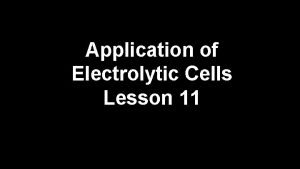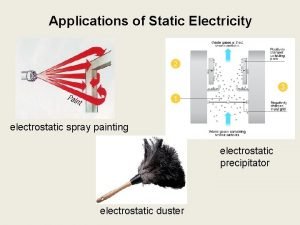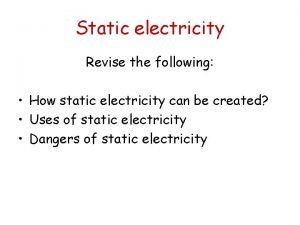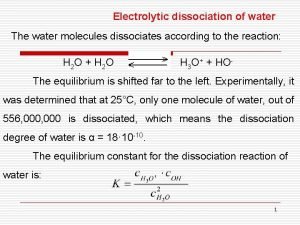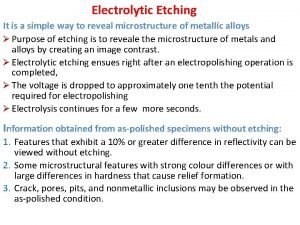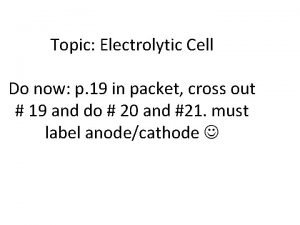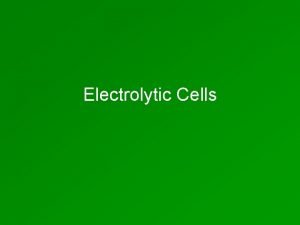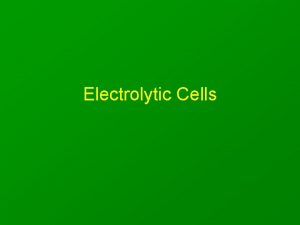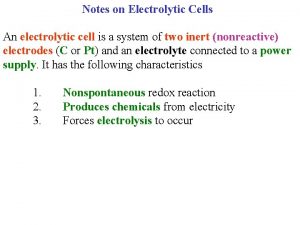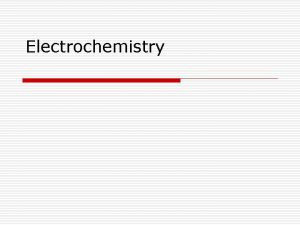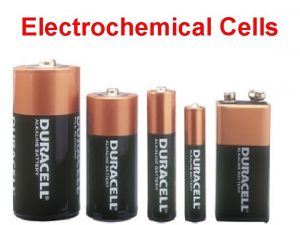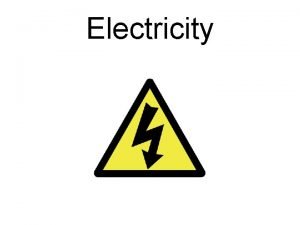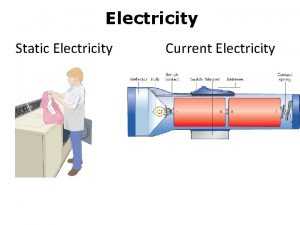Electrolytic Cells Electrolytic Cells Use electricity to force

















- Slides: 17

Electrolytic Cells

Electrolytic Cells • Use electricity to force a nonspontaneous reaction to occur. Endothermic. • Electrolytic cells can be identified by the presence of a battery or a power supply. • There are many kinds of electrolytic cells.

Chemical Potential Energy Galvanic Cell Electrolytic Cell Electrical Potential Energy

Electrolytic Decomposition of H 2 O H 2 is produced at one electrode, O 2 at the other. 2 H 2 O + energy 2 H 2 + O 2 Can you tell from the picture which electrode is producing H 2?

Reversing a Galvanic Cell This time: Zn is reduced & Cu is oxidized.

Two kinds of electrolytic cells • Fused Salt Cells – Preparation of pure metals (Fused means melted!) • Plating Cells – Designing surface to have specific properties

Fused Salt Cells • Used to purify metals from their ores.

Schematic of fused salt cell + + Ox: 2 Cl- Cl 2 + 2 e- - Red: Na+ + 1 e- Na

• Why does the Na. Cl have to be molten? • Which electrode will the Na+ ions be attracted to? • Which electrode will the Cl- ions be attracted to?

Industrial Setup


Electroplating Move desired coating from anode onto object to be plated. Solution contains ions of element to be plated.

Electroplating: Cu onto Al • Al is above Cu in Table J. • This reaction will not happen spontaneously. • Use an external energy source – a power supply or a battery – to force reaction to occur.

An Ox ate a Red Cat • Anode is still electrode at which oxidation occurs. • Cathode is still electrode at which reduction occurs. • Polarity of electrodes is different! – Anode is positive. – Cathode is negative.

A POX on Electrolytic Cells. • Anode – Positive – Oxidation • In an electrolytic cell, the polarity is determined by the outside power supply. • The anode is hooked up to the positive terminal and the cathode is hooked up to the negative terminal. • Look at drawings in Regents questions.

+ Battery + - Loses mass Anode = Oxidation Cu Cu+2 + 2 e. Cathode = Object to be Plated = Reduction Cu+2 + 2 e- Cu Gains mass Element to be plated. Cu+2 and SO 4 -2 Notice: Net reaction is just moving Cu around.

Cathode = object to be plated. Plating Anode is made of metal that you want to plate on object. Solution contains ions of plating metal.
 Applications of electrolytic cells
Applications of electrolytic cells Voltaic vs electrolytic cells
Voltaic vs electrolytic cells Khan academy balancing equations
Khan academy balancing equations Static electricity and current electricity
Static electricity and current electricity Electricity n
Electricity n How are static electricity and current electricity alike
How are static electricity and current electricity alike Use of static electricity in spray painting
Use of static electricity in spray painting How does a photocopier use static electricity to work
How does a photocopier use static electricity to work The safest ladder to use around electricity
The safest ladder to use around electricity Electrolytic dissociation definition
Electrolytic dissociation definition Applications of electrolytic cell
Applications of electrolytic cell Applications of electrolytic cell
Applications of electrolytic cell Applications of electrolytic cell
Applications of electrolytic cell Electrolytic decomposition example
Electrolytic decomposition example Electrolytic etching
Electrolytic etching Electrolytic capacitor polarity
Electrolytic capacitor polarity Smt for electrolytic cell
Smt for electrolytic cell Anode is positive or negative
Anode is positive or negative
